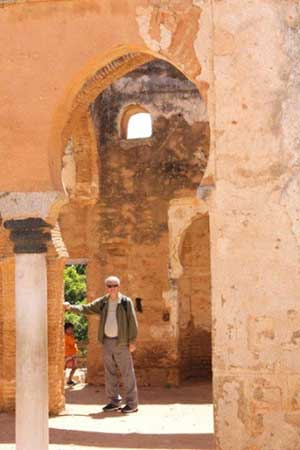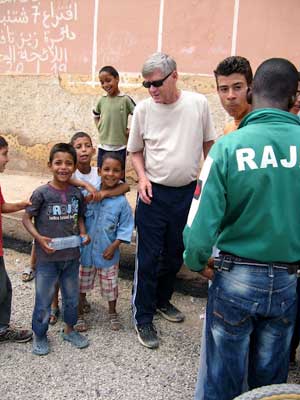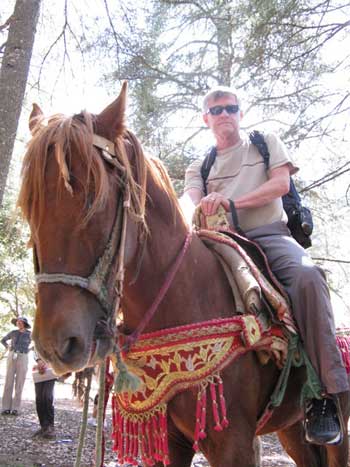Editor’s Note: the following excerpts are from Linda & Larry Smith’s travelogue of their June, 2012 trip to Spain.
2 weeks in Southern Spain (June, 2012)
 Spain’s history goes back 2,000 years. It is not uncommon to see buildings here that are at least 1,000 years old.
Spain’s history goes back 2,000 years. It is not uncommon to see buildings here that are at least 1,000 years old.
We started our trip at the Rock of Gibraltar after two weeks in Morocco. We spent two days there, then rented a car and set out for six days exploring the White Hill Towns of the Andalucía region starting at Arcos de la Frontera and continued on to Ronda, Zahara, Grazalema, Malaga, Granada, and Cordoba.
Most of these towns were built on the edges of limestone cliffs.
1,000 years ago some of these towns were Christian. Then the Muslims moved in for the next 400 – 600 years. Slowly the Catholic kings began to move the Muslims out starting about the year 1200, with the final push and victory happening in 1492.
Sevilla became Spain’s administrative center of the New World and in the process a VERY RICH town. We stood in the very rooms in Sevilla and Granada where Columbus made his pleas for ships to Queen Isabella and where Queen Isabella received his reports and stolen goodies a year later.
We also visited Columbus’ grave; a marble vault topped by four stone men in the act of “carrying” Columbus on their shoulders.
Spain has excellent highways, and an outstanding rail system, most of it built with borrowed money, which may sink the country after its mad dash into an unknown future. Even though most cities are 1,000 years old, they have been slightly redesigned to allow for sewers, water lines and auto routes. Many of the narrow streets only have enough room for one-way auto traffic. Scraped fenders and bumpers are a common sight. The cities have lots of parks. And the people use them.
 We spent part of the day at the giant former royal hunting grounds, now surrounded by downtown Madrid – Retiro Park. Thousands of families and tourists and young people out enjoying the warm day – napping, playing, sitting or picnicking on the grass.
We spent part of the day at the giant former royal hunting grounds, now surrounded by downtown Madrid – Retiro Park. Thousands of families and tourists and young people out enjoying the warm day – napping, playing, sitting or picnicking on the grass.
The Spanish are some of the cleanest people in the world! The cities and countryside are spotless, until it comes to cigarettes. It seems that most Spaniards smoke. And they throw their butts everywhere – most of the time without even snuffing the smoke out first.
Spain is supposed to be in an economic downfall, but judging from the high prices that people are paying for eating out, there must be plenty of consumer money. They dress nicely and drive nice cars and seem to live in nice houses. Our hotel rooms are running from $45 – $160 per night. Meals run $10 – $15 each, so we buy one $11 meal and split it. Plenty of food. The Spanish buy huge meals and seem to eat all the food. Fatness is also becoming a problem in this country.
Spain was at one time one of the richest countries in the history of the world, but they squandered their money on huge building projects and over-the-top art and war – war – war.
Unemployment is running close to 25%. Some regions stand at 36% – the highest of the Euro Union.
The Spanish are loud and continual talkers. Cops are everywhere in their patrol cars… eating sunflower seeds and spitting the hulls out on the streets. There are street sweeping men and women – many are black – working around the clock to keep the cities clean.
 It has been hard to get used to the 8:00 p.m. openings for most restaurants. Last night we attended a wonderful street concert on a plaza in Toledo. Spanish jazz. Thousands of people out…families with young kids, strolling around. Nobody looking the least bit tired…casually well dressed. So many of the women were wearing high heels while walking on cobblestones. The penny loafer shoe for men and boys is still in style in Spain.
It has been hard to get used to the 8:00 p.m. openings for most restaurants. Last night we attended a wonderful street concert on a plaza in Toledo. Spanish jazz. Thousands of people out…families with young kids, strolling around. Nobody looking the least bit tired…casually well dressed. So many of the women were wearing high heels while walking on cobblestones. The penny loafer shoe for men and boys is still in style in Spain.
Probably the saddest thing about this country are the empty but grand Catholic Churches. They have, for the most part, been turned into museums. Churches that could hold 10,000 are having Mass with perhaps a dozen people worshiping.
The climate here in southern Spain is similar to central California, between 80 – 90 degrees. Madrid is at 2,000 feet in elevation and that keeps the temperature a bit cooler.
One thing I found out here in Spain is they do not like to have people pick up a magazine at a newsstand and thumb through it. At a Spanish bus depot near Gibraltar I had a huge, fat, red-faced clerk jerk a Time Magazine right out of my hand.
The underground metro is outstanding. The former mayor of Madrid was nicknamed, “the Mole,” because he spent so much effort putting parking lots, rail lines, and roads underground.
Since the terrible metro bombing on May 11, 2004, security is really tight around town and especially around the metros and train depots.
 We have had lots of warnings about pickpockets. Last night after walking through several parks and plazas, both of our packs had been unzipped. Nothing had been taken – we think.
We have had lots of warnings about pickpockets. Last night after walking through several parks and plazas, both of our packs had been unzipped. Nothing had been taken – we think.
Spain is certainly a walking country. We usually walk between 2 – 12 miles a day.
European beds are mostly hard and the pillows are huge and thick. Tap water can be drunk in Spain, which saves money not having to buy water. Breakfast is usually included in the hotel price, but not always. At museum and church entries, most ticket takers speak Spanish to their customers, but for some reason we are often greeted in English. I guess we look foreign enough to not be Spanish.
Plan on bringing your own toilet paper since most restrooms do not provide towels or toilet paper.
Driving is a challenge…no accidents. Spanish drivers have much patience and seldom blow their horns, but will in a traffic circle if you slow down while reading signs.
Hotel floors start numbering at “0” or the ground floor. Really confusing. The 1st floor is really the second. And so forth. In some hotels the “1” floor would be the third floor in America. Go figure.
Linda and I have now been away from home for a bit over a month now and find ourselves getting anxious to get back home. It is interesting that the more we travel (73 countries to-date), the more we enjoy getting back to Oregon- there is no place as delightful as Historic Jacksonville.
